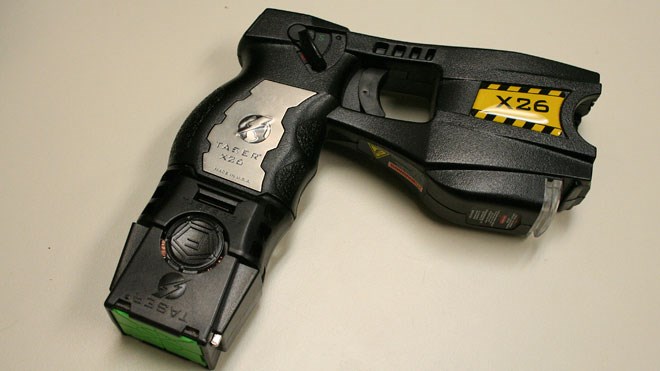While it's not clear when all 150 frontline officers with Greater Sudbury Police Service will be armed with new conducted energy weapons (CEW) — or stun guns — new provincial rules will allow for it to happen, just as soon as the money can be found.
Police Chief Frank Elsner said he fully supports the announcement made Tuesday that will allow police services to decide which officers will be permitted to carry the weapons; however, no money was included in that announcement.
“That's problematic,” said Elsner. “To roll this out across the province, all police services are looking at huge bills right now.”
Each stun gun unit costs upwards of $1,000 each, he said, which means police services across Ontario need to do a lot of number crunching to find the money for those units.
“We're looking at our budgets right now, and we're looking at a multi-year strategy on how to purchase these devices,” he said. “It's a huge money draw for us, and we're trying to do it the most cost-effective way possible.”
There's no timeframe in place as to when all of the stun guns will be purchased, or even when the first one will be purchased.
“The announcement just came out today, so we're just in the planning stages,” Elsner said.
Currently, the province restricts the use of these devices to certain designated positions and police teams such as members of tactical units, hostage rescue teams, containment teams and frontline supervisors.
The decision to allow police services to decide which officers can be equipped with the weapons is based on evidence that shows stun-gun use results in fewer significant injuries to both subjects and police officers when compared to other use-of-force options, according to a news release from the province.
Since stun guns were first introduced in Ontario in 2002, the government has been carefully reviewing independent research, stakeholder input, and the recommendations of several coroners' inquest juries, all of which contributed to this decision.
“There have been 12 coroner's inquests into deaths that involved the use of CEWs, and in all 12 instances, there have been recommendations to expand the use of CEWs,” Elsner said.
Right now, Greater Sudbury Police Service has between 20-25 stun guns.
Last year, stun guns were used three times in Sudbury. They are used in situations dealing with very violent individuals, primarily carrying some sort of weapon other than a firearm, Elsner said. They are effective tools in the police service's arsenal, and they give an officer alternatives other than having to rely solely on a firearm.
“With any kind of use of force we have, there is potential of lethal consequences,” he said. “That's why there are very strict guidelines and reporting policies in place with CEWs used by Greater Sudbury Police Service.
“There is a very rigorous training program our officers have to go through, which primarily deals with conflict resolution and when is the most appropriate time to use that particular weapon. The training isn't really on the mechanics of how to use the CEWs; they're pretty simple to use. It's when to use it.”
In Ontario, officers need to file a use-of-force report under certain circumstances, but primarily when a firearm is taken out of its holster; however, the same rules don't necessarily apply to stun guns, Elsner said.
That's why two years ago, Greater Sudbury Police Service implemented its own reporting system.
Each individual unit is equipped with its own computer that records every use and data such as how long the trigger was pulled and how many volts were delivered. In Sudbury, all of that information is recorded on the instrument, and at the end of every shift, the stun gun is put into a special holster, and all that information is downloaded.
“We know every single time our CEWs are used,” Elsner said, whereas, if an officer were to pull their firearm, but didn't file a report, there would be no record of that happening.
All of this information is also effective in helping to improve training methods and policies, he said.
Another benefit to having all frontline officers equipped with stun guns is they no longer have to wait for a supervisor to arrive on scene.
“Our geography in Sudbury is huge, and it could be quite some time before a supervisor was able to arrive,” Elsner said.
Join Sudbury.com+
- Messages
- Post a Listing
- Your Listings
- Your Profile
- Your Subscriptions
- Your Likes
- Your Business
- Support Local News
- Payment History
Sudbury.com+ members
Already a +member?
Not a +member?
Sign up for a Sudbury.com+ account for instant access to upcoming contests, local offers, auctions and so much more.



